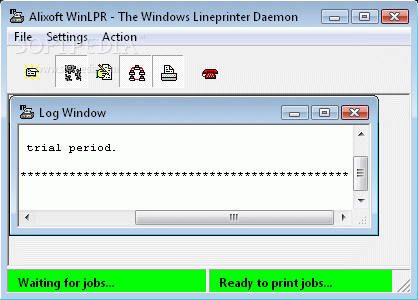WinLPR 3.07 Crack + Activation Code Download
The Windows Line Printer Daemon is an application that runs on your Windows PC, allowing your PC to accept print jobs from any Line Printer Protocol host.
This means you can have your mainframe, UNIX servers, NT servers all print to your PC even if you're not on the same physical or virtual network. You don't need to share your printer with your NT server, and you don't need complex resource sharing software for UNIX.

Download WinLPR Crack
| Software developer |
Alixoft LLC
|
| Grade |
2.4
911
2.4
|
| Downloads count | 7935 |
| File size | < 1 MB |
| Systems | Windows All |
The LPR protocol is an Internet standard supported by UNIX, NT, and most mainframe systems. It allows any machine that speaks LPR to talk to another machine to arrange a print job.
To accept a print job from a remote host, you need to have a daemon running. The daemon is a small program (WinLPR in this case) which listens for print jobs from a host or hosts, and accepts and prints them.
The daemon must be running to work properly, but it requires no user intervention to function.
WinLPR is also pretty small, simple and easy-to-use.
Here are some key features of "WinLPR":
■ Suppress or allow banner (who it came from) pages for each job and queue.
■ Confirm job before print, and insert CR/LF to combat "stair step" effect.
■ Full logging to a file.
■ Accept jobs from only sanctioned hosts.
■ Send Printer Control Files before and after print jobs to activate special features of your printer (such as change to landscape mode, etc.)
■ Create multiple queues for jobs. Each queue can print to a different printer, send leading and trailing control files to the printer to configure it, ask a user for job print confirmation, convert fineleeds to carriage return linefeed pairs and ban or allow hosts to send print jobs.
■ Take advantage of the "any" queue. The "any" queue is a special queue the WinLPR Serial creates for you. This queue allows you to accept any job, even if you don't know the "proper" queue name it was sent to, and send it to a printer. Again, you can perform manipulations like any other queue.
■ Hide unnecessary configuration information by turning advanced menus off, minimizing the chances a user will alter settings.
■ Remote management allowing you to control all settings (except language), turn accept and print job functionality on and off; print a test job and see the main log (since you connected) among other things, all through the Internet or your local TCP/IP network.
Limitations:
■ 40-days trial
